 English
English
Jabra Sanitary is a sanitaryware supplier offering toilets, sinks, faucets, bathtubs, etc., at competitive prices. If you're a distributor, wholesaler, or project contractor, get a quote today!
 $23.9 Limited-time Offer
$23.9 Limited-time Offer Consignment Policy
Consignment Policy 20 Years of Experience
20 Years of Experience
A kitchen sink is a vital fixture in any home kitchen, designed for washing dishes, preparing food, and cleaning up. Choosing the right kitchen sink size ensures efficient use of space and accommodates your cooking and cleaning needs effortlessly.
This guide walks you through the various kitchen sink sizes for different kitchen sink types. Besides, we will offer considerations when choosing a kitchen sink size and tips for measuring a new one.
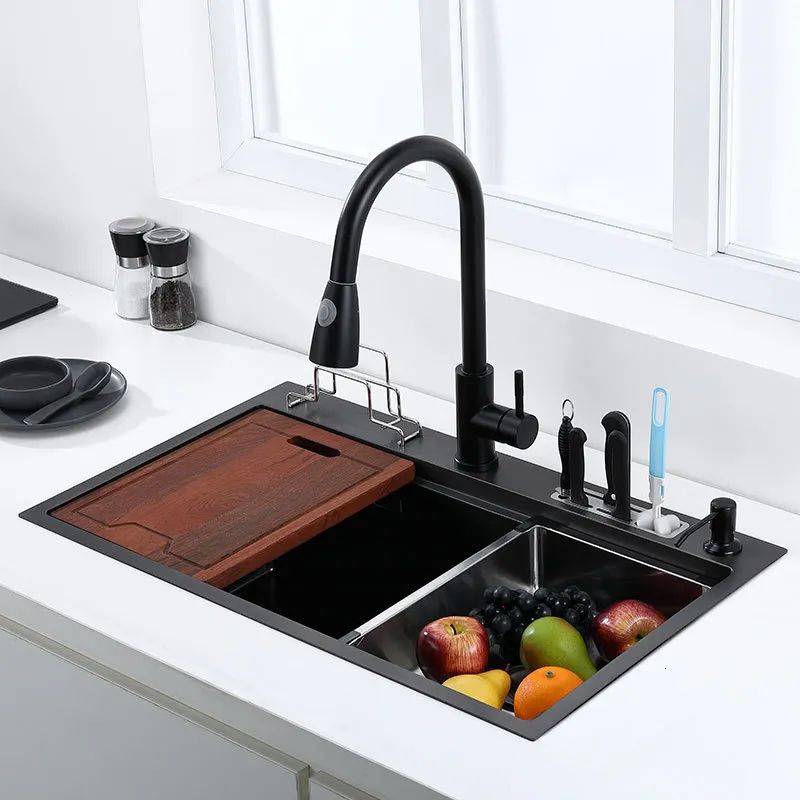
Table of Contents
Standard Kitchen Sink Sizes
Standard Depth of a Kitchen Sink
Types of Kitchen Sinks and Their Dimensions
What to Consider When Selecting a Kitchen Sink Size
How to Measure for a New Kitchen Sink?
FAQs
Conclusion: Find the Perfect Kitchen Sink Size
Standard Kitchen Sink Sizes
Understanding the standard sizes of kitchen sinks is the first step in making an informed choice. The standard kitchen sink dimensions from popular brands are 24 inches long by 30 inches wide.
Here's a breakdown of the most common kitchen sink sizes, their pros and cons, and their ideal uses:
(1) Small Sinks (18-24 inches)
- Best for: Small kitchens, apartments, or secondary sinks in larger kitchens.
- Pros: They take up less counter space, leaving more room for other activities.
- Cons: Limited space for washing large pots and pans.
(2) Medium Sinks (24-30 inches)
- Best for: Standard-sized kitchens with moderate counter space.
- Pros: Versatile and suitable for most everyday tasks.
- Cons: They may not accommodate very large cookware comfortably.
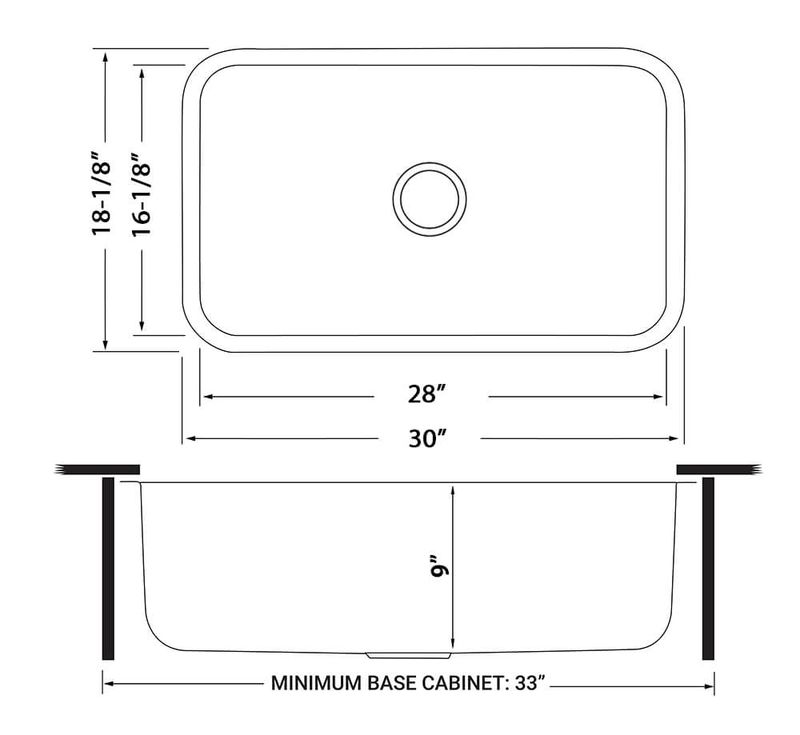
(3) Large Sinks (30-36 inches)
- Best for: Large kitchens, families, and avid cooks.
- Pros: Plenty of space for washing big pots, pans, and multiple dishes at once.
- Cons: They can take up significant counter space and may be less practical in smaller kitchens.
(4) Extra-large Sinks (36 inches or more)
- Best for: Commercial-style kitchens or those who frequently entertain large groups.
- Pros: They are ideal for extensive cooking and cleaning tasks.
- Cons: Require a substantial amount of counter space and may not fit in most residential kitchens.
In conclusion, when choosing a kitchen sink size, consider your kitchen layout, the types of cooking you do, and how much counter space you're willing to dedicate to your sink.
Standard Depth of a Kitchen Sink
The depth of your kitchen sink is just as important as its width and length. It affects how much water you can hold and how easily you can wash large items.
The standard depth of a kitchen sink is 8 to 10 inches. Here's a guide to the standard kitchen sink depths, their pros and cons, and their uses:
(1) Shallow Sinks (6-8 inches deep)
- Best for: Small kitchens with limited space or those who primarily wash small to medium-sized dishes.
- Pros: They are easier to reach and can be more comfortable for shorter users.
- Cons: Limited capacity for large pots and pans, and water can splash out more easily.
(2) Medium-depth Sinks (8-10 inches deep)
- Best for: Most home kitchens with a balance of small and medium-sized dishes.
- Pros: Provide enough depth for most tasks without taking up too much space.
- Cons: They may still not be deep enough for very large pots or deep-fryers.
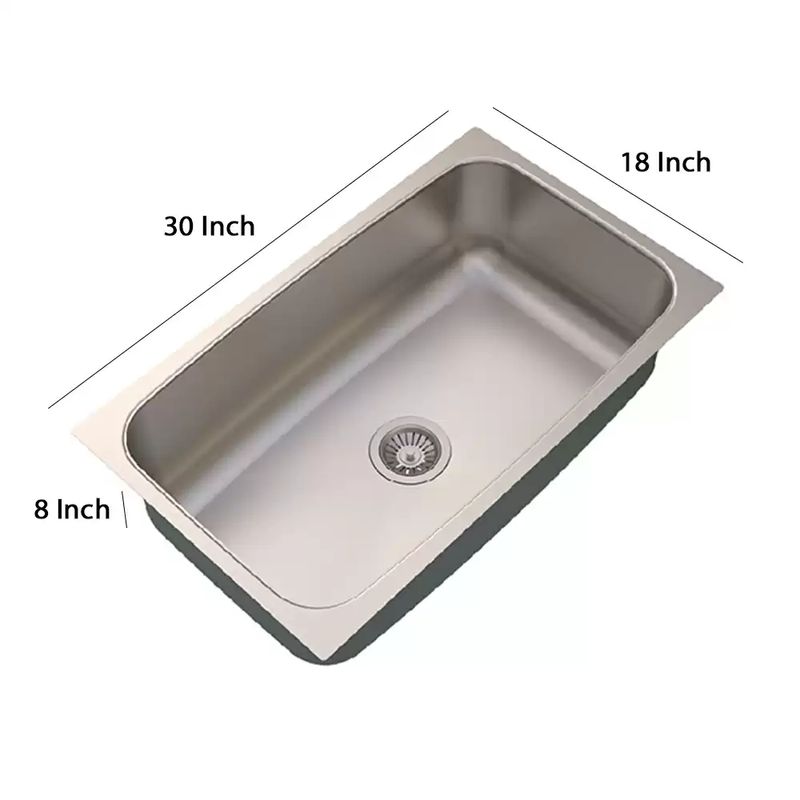
(3) Deep Sinks (10-12 inches deep)
- Best for: Large kitchens, families, and those who frequently wash large pots and pans.
- Pros: They can hold more water and accommodate larger items, reducing the risk of splashes.
- Cons: They may be more difficult to reach, especially for shorter users.
(4) Extra-deep Sinks (12 inches or more)
- Best for: Commercial kitchens or those who need to wash very large or tall items.
- Pros: Provide ample space for all types of dishes and can hold a lot of water.
- Cons: Requires more effort to reach the bottom and may be less practical for everyday use in a residential kitchen.
In conclusion, when choosing the depth of your kitchen sink, consider the types of dishes and cookware you use most often, as well as the comfort and accessibility for all users in your household.
Types of Kitchen Sinks and Their Dimensions
Understanding the different styles available can help you make an informed decision. Here are some types of kitchen sinks, their dimensions, and uses:
Type of Sink |
Dimensions |
Best For |
|---|---|---|
Single Bowl |
24-36 inches wide, 16-22 inches deep |
Those who need a large and unobstructed space for washing large pots and pans, or for food preparation. |
Double Bowl |
30-36 inches wide, 12-18 inches per bowl, 16-20 inches deep |
Families or those who need separate areas for washing and rinsing dishes or for food preparation and cleaning. |
Triple Bowl |
40-48 inches wide, 12-16 inches per bowl, 16-20 inches deep |
Large kitchens with ample space, or for those who need multiple areas for different tasks. |
Compact |
18-24 inches wide, 12-16 inches deep |
Small kitchens, apartments, or secondary sinks in larger kitchens. |
Farmhouse |
30-40 inches wide, 10-12 inches deep |
Those who want a rustic or farmhouse-style kitchen with a deep and spacious sink. |
Undermount |
24-36 inches wide, 16-20 inches deep |
Those who want a sleek and modern look with easy cleaning. |
Drop-in |
24-36 inches wide, 16-20 inches deep |
Those who want an affordable and easy-to-install option. |
Drainboard |
30-40 inches wide, 8-10 inches deep |
Those who need a dedicated space for draining dishes or drying produce. |
Single Bowl Kitchen Sink
In general, sinks up to 75-90cm long will have a single bowl. A single bowl sink can save on bench or counter space.
Double Bowl Kitchen Sink
Another name for a double sink. Many double bowl sinks have two bowls the same size or a configuration with one smaller and the other larger.
Triple Bowl Kitchen Sinks
A triple bowl sink has three compartments, which can be used for washing, rinsing, and sanitizing dishes. The three compartments can help to manage dirty dishes more efficiently and can be used to reduce clutter on countertops.
Compact Kitchen Sinks
A compact sink is a smaller and shallower kitchen sink designed to maximize space without sacrificing functionality. They are also known as bar sinks, prep sinks, or entertainment sinks.
Farmhouse Sinks
Farmhouse sinks are simple basins mounted on top of freestanding counters or kitchen tables. Since farmhouse sinks protrude out from the counter, they can make sizing a little tricky.
Undermount Sinks
An under-mount sink is installed beneath a countertop, creating a seamless transition from the countertop to the sink basin. Undermount sinks are also known as bottom-mount sinks.
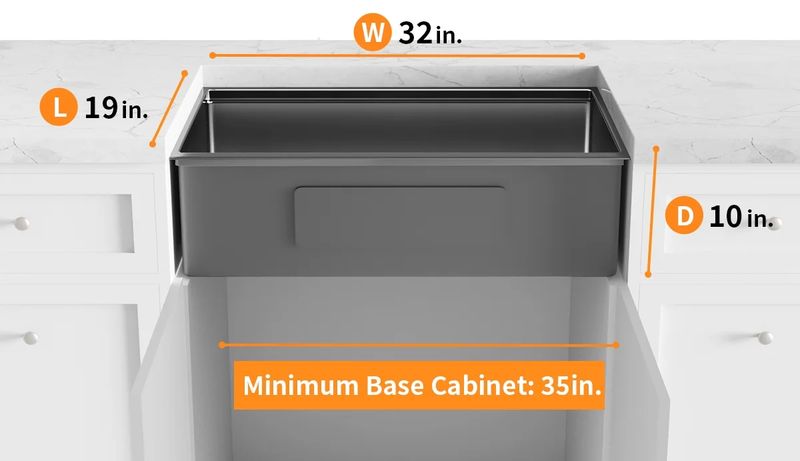
Drop-in Kitchen Sink
Drop-in sinks, also known as top-mount sinks, have features like pre-drilled faucet holes. These sinks are installed from the top and don't require professional installation for simple replacements.
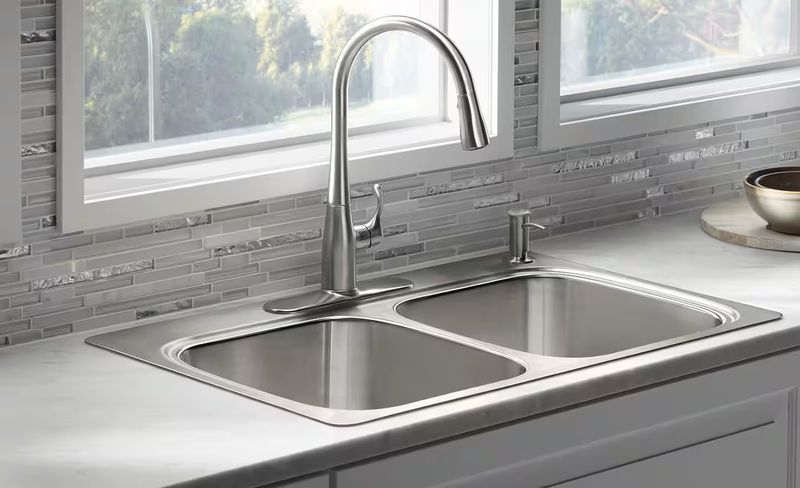
Drainboard Kitchen Sinks
A drainboard kitchen sink has a built-in drainboard that allows water to drain into the sink while dishes are drying.
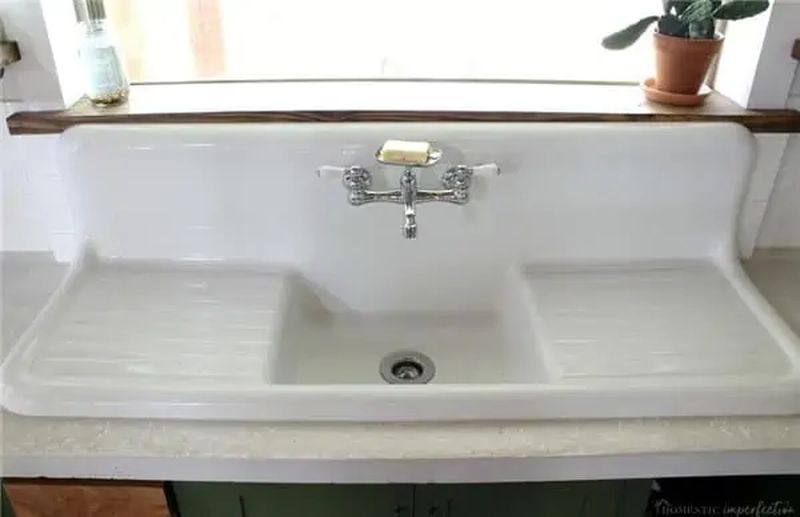
What to Consider When Selecting a Kitchen Sink Size
Choosing the right kitchen sink size involves several important considerations. Here's a detailed look at the factors you should take into account:
(1) Kitchen Size
The overall size of your kitchen plays a crucial role in determining the sink size. In a small kitchen, opt for a compact sink to avoid overcrowding. For a larger kitchen, a bigger sink can provide more functionality and space.
(2) Counter Space
The amount of available counter space around the sink is essential for practicality. Ensure there's enough space on both sides of the sink for food preparation and placing items while washing dishes.
(3) Number of Bowls
Decide whether you need a single, double, or even triple bowl sink based on your tasks. A double bowl sink is great for multitasking, while a single bowl offers more space for large items.
If you use one bowl for bigger tasks, a 60/40 split configuration might work better.
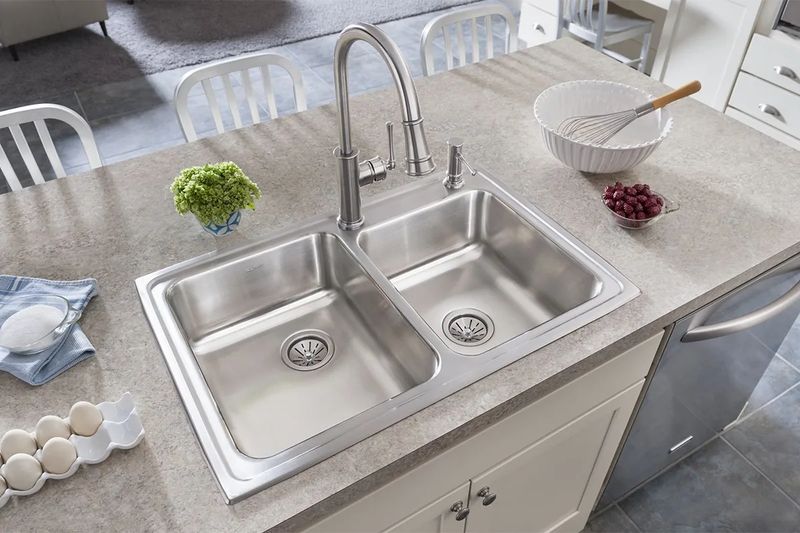
(4) Type of Sink
The type of sink (e.g., farmhouse, under-mount, drop-in) affects its size and installation. Farmhouse sinks impact sink width and depth due to their exposed fronts needing extra countertop depth.
This limits width choices compared to standard-sized under-mount or drop-in sinks, which fit pre-cut holes. Undermount sinks need smaller cutouts, while top-mount sinks sit over the countertop.
(5) Sink Shape
The shape of the sink (square, rectangular, round) can impact its functionality and aesthetic appeal. For example, a square sink or rectangular sink is highly functional since it offers more basin space compared to a round sink. You can fit more dishes or larger pots and pans due to their shape.
Curved corners, like those found in round or D-shaped sinks, can limit usable space.
(6) Usage Needs
Think about how you use your kitchen most often. If you frequently cook large meals or entertain, a larger sink with multiple bowls might be ideal.
For everyday use, a medium-sized sink could suffice. By carefully considering these factors, you can choose a kitchen sink size that meets your needs, enhances your kitchen's functionality, and complements your overall design.
How to Measure for a New Kitchen Sink?
Measuring for a new kitchen sink is a crucial step to ensure a perfect fit. Follow these steps to get accurate kitchen sink measurements:
Step 1: Determine Your Project Scope
Before you start measuring, decide whether you're replacing an existing sink or installing a new one as part of a kitchen remodel.
Here is how to measure a sink for replacement and installation respectively:
- Replacing a Sink: Focus on measuring the current sink and the surrounding area to find a suitable replacement.
- Installing a New Sink: Consider the overall kitchen layout and the desired location for the new sink.
Step 2: Measure Your Current Sink
If you're replacing an existing sink, measure the kitchen sink dimensions to get an idea of the size you need.
Here is how to measure a kitchen sink:
- Width: Measure the distance from one side of the sink to the other.
- Length: Measure the distance from the front to the back of the sink.
- Depth: Measure the distance from the top of the sink to the bottom.
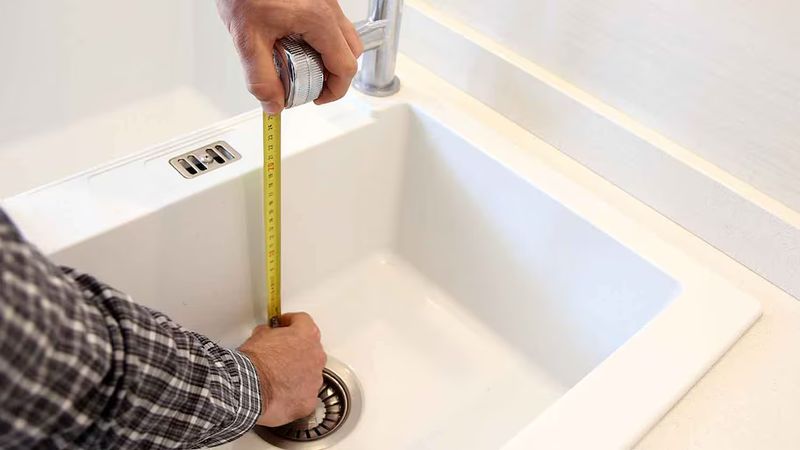
Step 3: Measure Available Width & Length
Measure the available space in your countertop where the new sink will be installed. Here is how to measure them:
- Width: Measure the distance between the edges of the countertop where the sink will fit.
- Length: Measure the distance from the back of the countertop to the edge where the sink will be placed.
Please note that you should ensure there's enough space for the sink and any additional features like a drainboard or faucet.
Step 4: Measure Sink Depth & Cabinet Depth
Check the depth of the sink and compare it to the depth of your cabinet. Here is how to measure them:
- Sink Depth: Measure the depth of the sink you plan to install.
- Cabinet Depth: Measure the depth of the cabinet to ensure the sink will fit comfortably without causing any issues.
This is especially important for sinks like farmhouse sinks, which have a deeper apron front.
FAQs
These FAQs should help answer some common questions about choosing and installing a kitchen sink.
(1) Can I install a kitchen sink myself?
Yes, you can install a kitchen sink yourself, but it requires some basic plumbing skills and tools.
If you're comfortable with cutting and sealing the countertop, connecting water and drain lines, and securing the sink, you can do it yourself.
However, if you're unsure or the installation involves complex modifications, it's best to hire a professional to ensure a safe installation.
(2) What size sink goes in a 36-inch cabinet?
A 36-inch cabinet typically accommodates a sink around 30-33 inches wide. This allows for a little extra space on each side of the sink for ease of installation and use.
However, the exact size may vary depending on the specific cabinet design and the type of sink you choose.
(3) Is a 27-inch kitchen sink too small?
A 27-inch kitchen sink might be considered small for a standard-sized kitchen, especially if you frequently cook large meals or have a lot of dishes to wash.
However, it can be suitable for smaller kitchens or secondary sinks where space is limited. Consider your usage needs and kitchen size to determine if a 27-inch sink meets your requirements.
(4) Can a larger sink be installed in an existing cabinet?
Installing a larger sink in an existing cabinet may be possible. But it depends on the cabinet's dimensions and the sink's size.
If the cabinet is wide enough and the sink fits within the available space, you can install a larger sink. However, you may need to modify the countertop or the cabinet itself to accommodate the sink properly.
It's best to consult with a professional or measure carefully before making any changes.
(5) Can you replace a kitchen sink without replacing your countertop?
Yes, you can replace a kitchen sink without replacing the countertop, especially if you're using a drop-in sink. Simply remove the old sink and install the new one in the existing cutout.
However, if you're switching to an under-mount sink or a different type of sink that requires a different cutout, you may need to modify the countertop or replace it entirely. Always remember to check the compatibility of the new sink with your countertop before making a purchase.
Conclusion: Find the Perfect Kitchen Sink Size
Choosing the perfect kitchen sink size is essential for creating a functional and beautiful kitchen. Consider your kitchen's size, available counter space, and your specific needs when selecting a kitchen sink. Remember, the right kitchen sink size can enhance your cooking experience and make everyday tasks more enjoyable.
If you want to buy a kitchen sink guide for the perfect kitchen sink size, you can choose Jabra Sanitary, a reliable kitchen sink manufacturer. It offers purchasing recommendations and installation services with every purchase for a hassle-free experience.






















